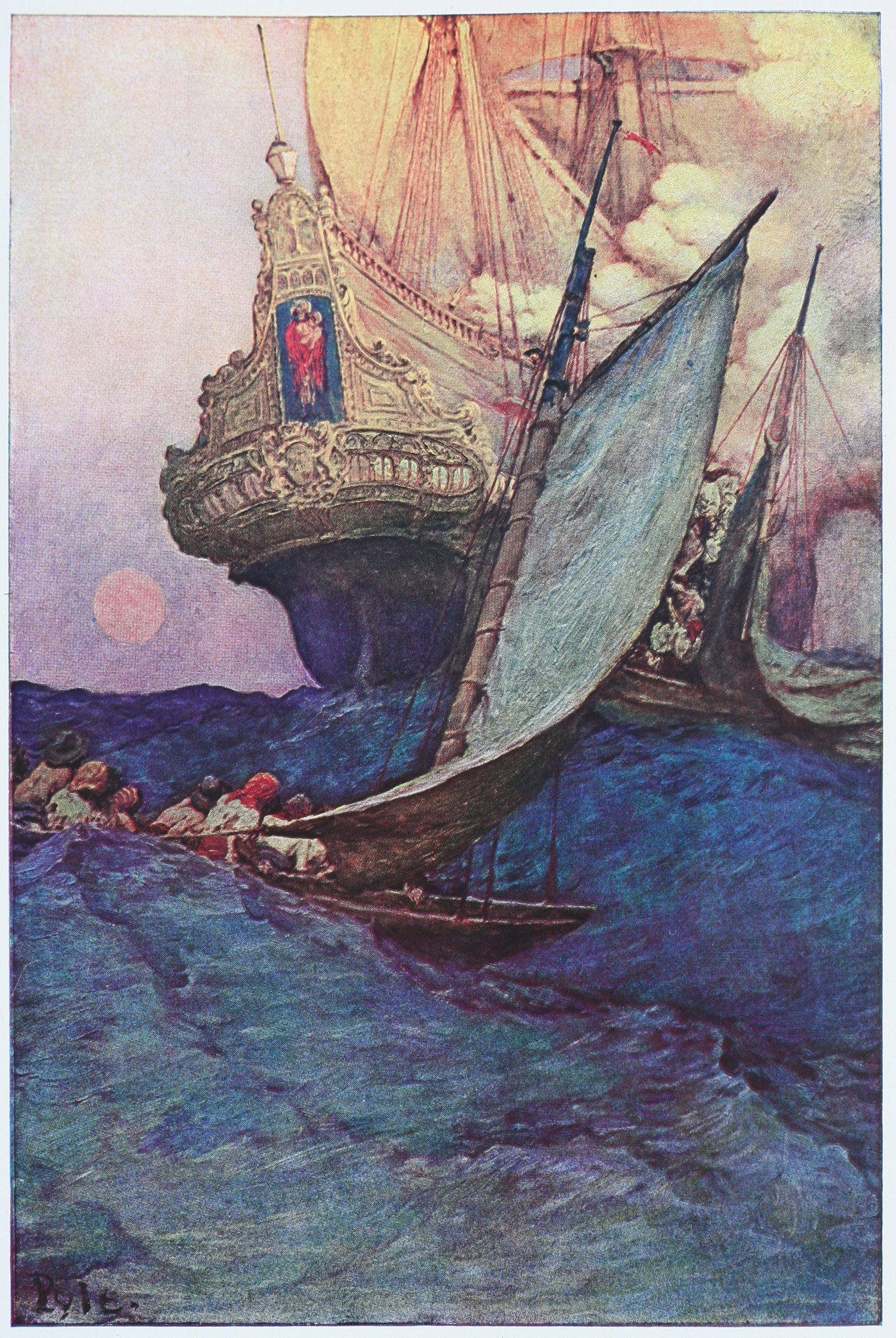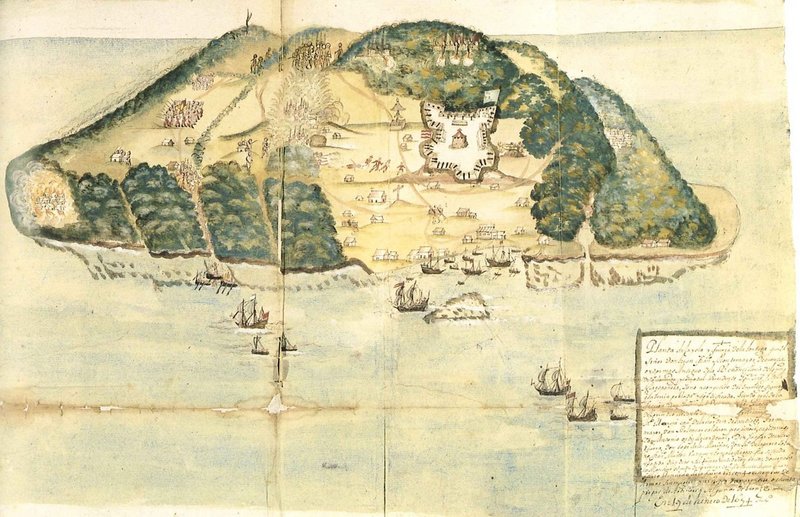|
Battle Of Santiago (1660)
The Battle of Santiago (1660) was an engagement between Dominican militia and French buccaneers. Conflict Pirates out of Tortuga attacked the Dominican town of Santiago de los Caballeros on March 27, 1660. Some 25 or 30 Spaniards were killed outright during their initial onslaught. After ransacking the town, they departed with a number of hostages on March 29, 1660. Several hundred Dominican militia cavalrymen had in the interim managed to rally from throughout the district, and prepared an ambush ahead of the French column. The leading two buccaneers were shot dead and a two-hour firefight ensued, before the Dominicans finally broke. See also * Battle of Sabana Real The Battle of Sabana Real (Spanish: ''Batalla de Sabana Real)'' took place on January 21, 1691. An army of 700 Dominican raiders and 2,600 militiamen aboard five warships of the Armada de Barlovento, circled and overwhelmed 1,000 French defenders ... * Dominican-French War References *{{Citation, title=Pirates o ... [...More Info...] [...Related Items...] OR: [Wikipedia] [Google] [Baidu] |
Santiago De Los Caballeros
Santiago de los Caballeros (; '' en, James, son of Zebedee, Saint James of the Knights''), often shortened to Santiago, is the second-largest city in the Dominican Republic and the fourth-largest city in the Caribbean by population. It is the capital of Santiago Province (Dominican Republic), Santiago Province and the largest major metropolis in the Cibao region of the country, it is also the largest non-coastal metropolis in the Caribbean islands. The city has a total population of 1,173,015 inhabitants. Santiago is located approximately northwest of the capital Santo Domingo with an average altitude of 178 meters (584 ft). Founded in 1495 during the first wave of European colonization of the Americas, European settlement in the New World, the city is the "first Santiago (other), Santiago of the Americas". Today it is one of the Dominican Republic's cultural, political, industrial and financial centers. Due to its location in the fertile Cibao Valley it has a robus ... [...More Info...] [...Related Items...] OR: [Wikipedia] [Google] [Baidu] |
Flag Of New Spain
This is a list of Spanish flags, with illustrations. For more information about the national flag, visit the article Flag of Spain. National flags Royal standards Regional flags Provincial flags The provinces of A Coruña (province), La Corunna, Alicante (province), Alicante, Castellón (province), Castellón, Valencia (province), Valencia and Zamora (province), Zamora do not have a flag. File:Álava.svg, Álava File:Bandera provincia Albacete.svg, Albacete (province), Albacete File:No flag.svg, Alicante (province), Alicante (No Flag) File:Flag Almería Province.svg, Almería (province), Almería File:Flag of Asturias.svg, Asturias File:Bandera de la provincia de Ávila.svg, Ávila (province), Ávila File:Provincia de Badajoz - Bandera.svg, Badajoz (province), Badajoz File:Flag of the Balearic Islands.svg, Balearic Islands Flag of Barcelona (province).svg, Barcelona (province), Barcelona File:Provincia Burgos Flag.PNG, Burgos (province), Burgos File:Bandera de Cáceres ... [...More Info...] [...Related Items...] OR: [Wikipedia] [Google] [Baidu] |
Milita
A militia () is generally an army or some other fighting organization of non- professional soldiers, citizens of a country, or subjects of a state, who may perform military service during a time of need, as opposed to a professional force of regular, full-time military personnel; or, historically, to members of a warrior- nobility class (e.g. knights or samurai). Generally unable to hold ground against regular forces, militias commonly support regular troops by skirmishing, holding fortifications, or conducting irregular warfare, instead of undertaking offensive campaigns by themselves. Local civilian laws often limit militias to serve only in their home region, and to serve only for a limited time; this further reduces their use in long military campaigns. Beginning in the late 20th century, some militias (in particular officially recognized and sanctioned militias of a government) act as professional forces, while still being "part-time" or "on-call" organizations. For ... [...More Info...] [...Related Items...] OR: [Wikipedia] [Google] [Baidu] |
Buccaneer
Buccaneers were a kind of privateers or free sailors particular to the Caribbean Sea during the 17th and 18th centuries. First established on northern Hispaniola as early as 1625, their heyday was from Stuart Restoration, the Restoration in 1660 until about 1688, during a time when governments were not strong enough and did not consistently attempt to suppress them. Originally the name applied to the landless hunters of wild boars and cattle in the largely uninhabited areas of Tortuga (Haiti), Tortuga and Hispaniola. The meat they caught was smoked over a slow fire in little huts the French called ''boucans'' to make ''viande boucanée'' – ''jerked meat'' or ''jerky'' – which they sold to the French corsairs, corsairs who preyed on the (largely Spanish) shipping and settlements of the Caribbean. Eventually the term was applied to the corsairs and (later) privateers themselves, also known as the Brethren of the Coast. Though corsairs, also known as ''filibusters'' or ''freeb ... [...More Info...] [...Related Items...] OR: [Wikipedia] [Google] [Baidu] |
Tortuga (Haiti)
Tortuga Island (french: Île de la Tortue, ; ht, Latòti; es, Isla Tortuga, , ''Turtle Island'') is a Caribbean island that forms part of Haiti, off the northwest coast of Hispaniola. It constitutes the ''commune'' of Île de la Tortue in the Port-de-Paix arrondissement of the Nord-Ouest department of Haiti. Tortuga is in size and had a population of 25,936 at the 2003 Census. In the 17th century, Tortuga was a major center and haven of Caribbean piracy. Its tourist industry and references in many works have made it one of the most recognized regions of Haiti. History The first Europeans to land on Tortuga were the Spanish in 1492 during the first voyage of Christopher Columbus into the New World. On December 6, 1492, three Spanish ships entered the Windward Passage that separates Cuba and Haiti. At sunrise, Columbus noticed an island whose contours emerged from the morning mist. Because the shape reminded him of a turtle's shell, he chose the name of Tortuga. Tortuga wa ... [...More Info...] [...Related Items...] OR: [Wikipedia] [Google] [Baidu] |
Battle Of Sabana Real
The Battle of Sabana Real (Spanish: ''Batalla de Sabana Real)'' took place on January 21, 1691. An army of 700 Dominican raiders and 2,600 militiamen aboard five warships of the Armada de Barlovento, circled and overwhelmed 1,000 French defenders at Sabana de la Limonade; Governor de Cussy and 400 of his followers were killed. This incident, among others, led Spain to formally recognize French control of some Caribbean territory in the Treaty of Ryswick in order to avoid further conflicts again in the future: Tortuga Island and the western third of the adjacent island of Hispaniola, where the French colony of Saint-Domingue Saint-Domingue () was a French colony in the western portion of the Caribbean island of Hispaniola, in the area of modern-day Haiti, from 1659 to 1804. The name derives from the Spanish main city in the island, Santo Domingo, which came to refer ... was later established. References {{Reflist History of the Colony of Santo Domingo 17th century in the C ... [...More Info...] [...Related Items...] OR: [Wikipedia] [Google] [Baidu] |
Dominican-French War
The siege of Santo Domingo (1808) was the second and final major battle of the Spanish reconquest of Santo Domingo and was fought between November 7, 1808 and July 11, 1809 at Santo Domingo, Captaincy General of Santo Domingo. A force of Dominican and Puerto Rican of 1,850 troops led by Gen. Juan Sánchez Ramírez, with a naval blockaded by British Commander Hugh Lyle Carmichael, besieged and captured the city of Santo Domingo after an 8 months garrisoning of 2,000 troops of the French Army led by General Dubarquier. Background Upon hearing the news of Napoleon's invasion of Spain in 1808, Juan Sánchez Ramírez launched a war against the French troops who were nominally controlling the island. After some initial defeats, the loyalists managed a key victory in November, in the Battle of Palo Hincado, where Sánchez Ramírez's 2,000 soldiers overwhelmed Gen. Louis Ferrand's 600. There, with his numbers diminished owing to the desertion of Dominicans, the French commander fac ... [...More Info...] [...Related Items...] OR: [Wikipedia] [Google] [Baidu] |
History Of The Colony Of Santo Domingo
History (derived ) is the systematic study and the documentation of the human activity. The time period of event before the invention of writing systems is considered prehistory. "History" is an umbrella term comprising past events as well as the memory, discovery, collection, organization, presentation, and interpretation of these events. Historians seek knowledge of the past using historical sources such as written documents, oral accounts, art and material artifacts, and ecological markers. History is not complete and still has debatable mysteries. History is also an academic discipline which uses narrative to describe, examine, question, and analyze past events, and investigate their patterns of cause and effect. Historians often debate which narrative best explains an event, as well as the significance of different causes and effects. Historians also debate the nature of history as an end in itself, as well as its usefulness to give perspective on the problems of the p ... [...More Info...] [...Related Items...] OR: [Wikipedia] [Google] [Baidu] |
Battles Involving France
A battle is an occurrence of combat in warfare between opposing military units of any number or size. A war usually consists of multiple battles. In general, a battle is a military engagement that is well defined in duration, area, and force commitment. An engagement with only limited commitment between the forces and without decisive results is sometimes called a skirmish. The word "battle" can also be used infrequently to refer to an entire operational campaign, although this usage greatly diverges from its conventional or customary meaning. Generally, the word "battle" is used for such campaigns if referring to a protracted combat encounter in which either one or both of the combatants had the same methods, resources, and strategic objectives throughout the encounter. Some prominent examples of this would be the Battle of the Atlantic, Battle of Britain, and Battle of Stalingrad, all in World War II. Wars and military campaigns are guided by military strategy, whereas bat ... [...More Info...] [...Related Items...] OR: [Wikipedia] [Google] [Baidu] |
Conflicts In 1660
Conflict may refer to: Arts, entertainment, and media Films * ''Conflict'' (1921 film), an American silent film directed by Stuart Paton * ''Conflict'' (1936 film), an American boxing film starring John Wayne * ''Conflict'' (1937 film), a Swedish drama film directed by Per-Axel Branner * ''Conflict'' (1938 film), a French drama film directed by Léonide Moguy * ''Conflict'' (1945 film), an American suspense film starring Humphrey Bogart * ''Catholics: A Fable'' (1973 film), or ''The Conflict'', a film starring Martin Sheen * ''Judith'' (1966 film) or ''Conflict'', a film starring Sophia Loren * ''Samar'' (1999 film) or ''Conflict'', a 1999 Indian film by Shyam Benegal Games * ''Conflict'' (series), a 2002–2008 series of war games for the PS2, Xbox, and PC * ''Conflict'' (video game), a 1989 Nintendo Entertainment System war game * '' Conflict: Middle East Political Simulator'', a 1990 strategy computer game Literature and periodicals * ''Conflict'' (novel ... [...More Info...] [...Related Items...] OR: [Wikipedia] [Google] [Baidu] |




.jpg)
